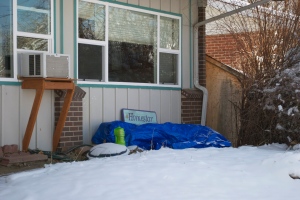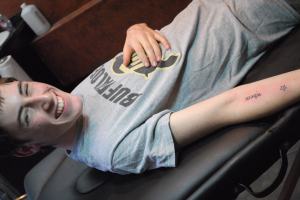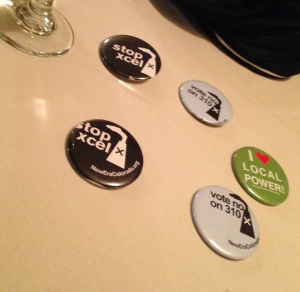By Lauren Maslen
Hallway chair races, classroom dance parties, and group sing alongs. Morale boosters like these were the ingredients that helped boost the spirit of some teachers and students across Boulder Valley schools after floods poured through their classrooms in September.
“Some children donated their life savings – their piggy banks – to the Crest View fund,” Merlyn Holmes, a parent of a Crest View Elementary first grader, said. “They were aware that this was a big deal and they were really happy to have a school to go to and to help.”
When heavy rains and disastrous floods hit Boulder County in September 2013, they not only impacted educators all over Boulder Valley School District, but students as well. Teachers and staff were able to keep their cool, though. They not only handled the event well and managed problems as they arose, but they taught valuable lessons to their students along the way. Lessons like: how does a rain cycle work? Why is rain good for our planet and how could it be harmful in a flood? And maybe most importantly: how can we help our community?
This lesson wasn’t just one for the kids. It was one for the adults, too.
Briggs Gamblin is Boulder Valley School District’s director of communications and legislative policy. This wasn’t the first flood Boulder experienced, he said, but it was unique in the challenges it presented. The floods blocked off access to all of Boulder’s major canyons. This made BVSD’s job of getting help to the schools, students, and teachers difficult, but even more imperative.
Boulder Valley School District is the seventh largest school district in Colorado. Over half of BVSD’s buildings were damaged in September’s floods and four of those buildings received, “moderate to severe damage,” according to a letter written by Superintendent Bruce K. Messinger to Colorado Governor John Hickenlooper. The total damage to the school district totaled close to $5 million.
Included in Messinger’s letter was a cost estimate submitted to the Federal Emergency Management Agency. Among those costs? An alternate program site for Crest View Elementary School students, food spoilage, fiber optic network damage, reconstruction, remediation, and clean up.
Officials realized the challenge that lay before them on Thursday, September 12. “The one school that really sustained some damage beyond that which could be handled by our maintenance people was Crest View Elementary School,” Gamblin said. Although the flood waters were initially controlled with tarps and sandbags in doorways of the building, they burst through on three more occasions. This flooded 85 percent of the building and kept kids out of school for over two weeks.
Crest View Strong
Merlyn Holmes was woken by a phone call during the night of September 12th.
“Our first thoughts were, ‘Oh goody, we have a rain day!’ We were a bit slow on the uptake. It seemed more like a snow day than an emergency,” Holmes said.
Holmes’ property is safely nestled near a retention pond not far from Crest View Elementary. “We watched that retention pond fill and drain and fill and drain repeatedly. It was really very beautiful and peaceful,” she said.
As the day progressed, however, Holmes and her family quickly realized the severity of the rain. The family walked to the Broadway underpass near their house, and realized the flood waters were raging.
“Our big question was: where were these waters going?” Holmes said. “It was only later the next day that we visited Crest View and we were shocked at seeing all the flood damage. There was a waterfall going through the playground.”
Holmes’ 6 year old son, Landryk, was out of school for two and a half weeks. “We did a lot of juggling at that time with work schedules and trying to figure out what would be best for our son,” she said.
An alternate program was made available through a partnership between BVSD and the YMCA. Teachers and some substitutes held classes at the Lafayette YMCA, including kindergarten enrichment teacher, Jill Williams, whose class became very interested in learning about rain.
“It was only natural to look out the window and talk about something we were experiencing and feeling depressed over, together,” said Williams. She shared the book “What Makes Rain: the Story of a Raindrop” with her kindergarteners.
Video of Crest View Elementary students in Jill Williams’ kindergarten enrichment class, courtesy Jill Williams.
Williams said that other teachers connected with their students during the flood in a multitude of ways, including video lessons and websites set up with lessons and educational material.
Buses were provided for students to attend the program which was offered at $50 per day to families and at no cost to those who self-identified as being on free and reduced lunch programs.
Volunteers offered to help at the school, said Gamblin, but because of health and safety concerns, professionals had to be brought in to do the job first. 13 days of non-stop construction and repair work aided in recovering the school from much of the damage. “Machines were clunking away at Crest View at 3 a.m.,” Gamblin said. “The neighbors were great. They also suffered damage and they were very supportive.”
Anything that was absorbent had to go – materials, books, shelving, drywall, and carpets. What could be salvaged was loaded into unmarked cardboard boxes for teachers to sort through once they were allowed to return to the building.
Home Depot built shelving for teachers and puppet theaters for the kindergarten classrooms. Numerous businesses and other schools donated supplies and books to Crest View. “KidKraft donated free items to the kindergarten teachers, so I received a dollhouse for my room,” Williams said. SERVPRO, the company in charge of cleaning and restoration of the school also threw a Halloween party for their own staff and Crest View faculty.
The school’s outdoor vegetable garden and its Habitat and wetlands areas are still damaged. Asbestos and mold tests are continuing to be conducted throughout the year. And until recently, hot lunches were prepared off-site and brought to the school for lunchtime.
But is the school back to “normal” yet?
“Kids are so adaptable at this age,” Holmes said. The students were able to settle back into a day-to-day routine of learning, “even when they were on concrete floors and had no books on the shelves.”
“Crest View’s community is amazing and [principal] Ned Levine is even more amazing,” Williams said. “We never could have recovered without either of them. But we’re still not recovered. I think it won’t really be right until spring and maybe not completely normal until next fall.”
“Crest View was a challenge. At that point, we didn’t know how big of a challenge it would be,” Gamblin said.
Jamestown Elementary School was also a challenge for BVSD, but for different reasons.
The school was used as an evacuation center for the town and “will need some soap and water,” Gamblin said. Jamestown’s challenge is on a different level than Crest View’s, however.
The school is intact and the students are learning. The town, meanwhile, faces an overhaul, leaving the school to play a waiting game. “We’re just waiting for full-town service access,” Gamblin said.
A Home for Jamestown Elementary
Jamestown, Colo. suffered extreme devastation after September’s floods. With only some roads recently repaired, structures still damaged, and a water distribution system that remains offline, the town’s school, Jamestown Elementary, was forced to relocate for the year.
Beth Brotherton is the principal’s assistant at Jamestown Elementary School. After September’s floods, Brotherton decided to remain in her home in Jamestown and with her students.
Jamestown West recently settled into its new home for the year in Glacier View Ranch at Colorado Mountain Conference Center in Ward, Colo. The school currently has 14 students in first through fifth grade and two instructors, including Brotherton.
Meanwhile, Jamestown East is located in a classroom in Community Montessori in Boulder. The classroom is home to six students in third through fifth grade, and one part-time kindergartener. The students’ teacher from Jamestown Elementary went with her students to their new classroom in Boulder.
Many families from Jamestown Elementary are open-enrolled and their homes are located above the mountains. They received minimal water damage, Brotherton said. Shortly after the flood, The families met to discuss what would be best for the town, their children’s education, and for the well-being of each of their families.
One first grader’s family offered their home to use as a school. The fire department helped bring in tables for students to work on. Carpets were removed and a cork floor was installed.
On the first Wednesday back in class, 16 children showed up to their new classroom. “We stayed there for six weeks and we taught there for six weeks,” Brother said.
Volunteers came to teach music lessons twice a week. Recess was held in the backyard with a swing set and fort, and the kids ate lunch at the picnic tables outside.
This temporary school was something the children will remember forever. It couldn’t last, though. “The district brought us all together and asked us what we wanted. We knew we couldn’t legally stay there,” Brotherton said.
BVSD planned to use modular classrooms on the property of Glacier View Ranch. But between high costs, wind, and the trouble of transporting the modulars along the severely damaged roads, officials quickly realized this wouldn’t work.
The district negotiated with Glacier View Ranch to use a building on the property. “A beautiful log cabin, actually. It’s as big as Jamestown Town Hall,” Brother said.
Brotherton said that learning is definitely happening at Glacier View Ranch. The building is “very homey… It’s a good place for the kids.”
“It really is amazing how well it’s working out,” Brotherton said. “We feel really safe up there. The district really took care of us. They did a good job.”
A Lasting Impact
Gamblin said that between flood insurance, money from FEMA, grants from the state, and funds raised by the Colorado non-profit Impact on Education, virtually all of BVSD’s losses will be covered.
“One of the things about a crisis is that people don’t stop and ask, ‘Is that my area?’ People just do it. People organize quickly and they identify needs quickly,” Gamblin said.
Holmes said that although there is always room for improvement, she was impressed with how BVSD handled the situation.
“The one area where I hope all this will have a lasting impact on the children is in not taking things for granted and being grateful. I know we parents feel that and I’m sure the staff and faculty do, too,” said Holmes.






